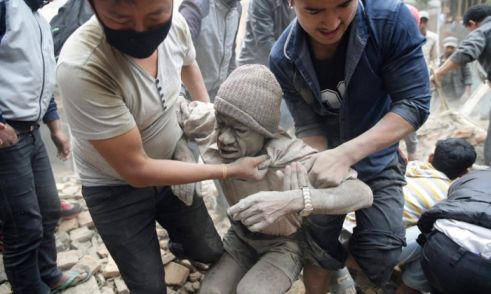Updated 26 April 2015
By Jane Scobie
A powerful earthquake measuring 7.8 on the Richter scale struck an area between Nepal’s capital Kathmandu and the city of Pokhara at 11:41am local time on Saturday 25 April. A strong aftershock on Sunday caused further panic and frustrated efforts to reach survivors.

Death toll rising rapidly
Nepal home ministry officials now say over 2,500 people were killed and more than 5,000 were injured. These numbers are expected to rise again.
HelpAge South Asia Regional Director in Nepal, Peter McGeachie said:
“We have serious concerns for the areas in between the two cities. No information is available from them at the moment.
“We are in contact with UN and local authorities to carry out an urgent assessment of the situation and plan our response.”
Huge numbers affected
The government has reported that a total of 30 districts have been affected in the Western and Central Regions, including Kathmandu Valley districts.
2.5 million people live in densley populated Kathmandu Valley, many in buildings not fit to withstand a significant seismic event. 6.6 million live within the affected areas.
It is reported that private and government hospitals have run out of space and are treating patients outside.
Tent cities have sprung up for those displaced by the earthquake in Nepal. Many people lost their homes and those that didn’t are afraid to go back to them because of the aftershocks.
Hundreds of thousands of people in central Nepal will be spending a second night outdoors.
Older people among most vulnerable
Around 9% of Nepal’s population of 27 million is 60 or over. There is strong evidence that older persons suffer disproportionately from disasters even in developed countries.
In 2005, 75% of those killed by Hurricane Katrina were over 60 but made up just 15% of the population in New Orleans. In 2011, 56% of those who died in the Great East Japan Earthquake and Tsunami were 65 and over, despite comprising just 23% of the population.
Nepal ranks at number 30 in HelpAge’s Disaster Risk and Age Index, which assesses the the disaster risk faced by older people in 190 countries.
“Older people bear the initial brunt of disasters often because they cannot flee,” said HelpAge International’s Chief Executive, Toby Porter.
“This is compounded by the lack of essential medications for older people, such as those to treat diabetes, being available after disasters. And the mental fall-out from disasters is huge. Older women and men are ready to help others but are often too proud to help themselves.”
Challenges lie ahead
Aftershocks are expected to continue for some time, causing further damage and debilitating an already weak infrastructure.
Limited access to affected areas is expected to hamper search and rescue efforts. Clearing the debris could take weeks.
Rain is predicted throughout the next three days and people
will need shelter.
Rapid response
The HelpAge network has extensive experience of responding quickly to the needs of older people in the region.
HelpAge India has a disaster response model that is equipped to rush in quickly to reach out, not only to older people, but also to the wider community. At times of large scale disasters this model provides rapid relief in the form of food, clothing and shelter.
How you can help
Donate now to help survivors of this devastating earthquake.
